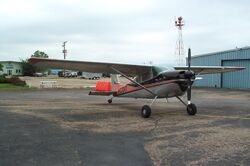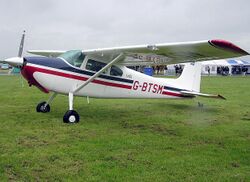Engineering:Cessna 180 Skywagon
| Cessna 180 Skywagon | |
|---|---|

| |
| Role | Light utility aircraft |
| Manufacturer | Cessna |
| First flight | May 26, 1952 |
| Introduction | 1953 |
| Produced | 1953–1981 |
| Number built | 6,193 |
| Variants | St-Just Cyclone St-Just Super-Cyclone |
| Developed into | Cessna 182 Skylane Cessna 185 Skywagon |
The Cessna 180 Skywagon is a four- or six-seat, fixed conventional gear general aviation airplane which was produced between 1953 and 1981. Though the design is no longer in production, many of these aircraft are still in use as personal aircraft and in utility roles such as bush flying.[1]
Development
Cessna introduced the heavier and more powerful 180 as a complement to the Cessna 170. It eventually came to be known as the Skywagon.[1]
The prototype Cessna 180, N41697, first flew on May 26, 1952. Cessna engineering test pilot William D. Thompson was at the controls.[2]
In all its versions, 6,193 Cessna 180s were manufactured. In 1956, a tricycle gear version of this design was introduced as the Cessna 182, which came to bear the name Skylane. Additionally, in 1960, Cessna introduced a heavier, more powerful sibling to the 180, the conventional gear Cessna 185. For a time, all three versions of the design were in production.[1]
Design
The airframe of the 180 is all-metal, constructed of aluminum alloy. The fuselage is a semi-monocoque structure, with exterior skin sheets riveted to formers and longerons. The strut-braced wings, likewise, are constructed of exterior skin sheets riveted to spars and ribs. The landing gear of the 180 is in a conventional arrangement, with main gear legs made of spring steel, and a steerable tailwheel mounted on a hollow tapered steel tube.[1]
Cessna 180s produced between 1953 and 1963 have two side windows, while 1964 to 1981 models feature three side windows, as they use the same fuselage as the Cessna 185. 180s can be equipped with floats and skis.[1]
Operational history
Record flight
The Cessna 180 gained recognition as the aircraft chosen by Geraldine Mock, the first woman pilot to successfully fly around the world. The flight was made in 1964 in her 1953 model, the Spirit of Columbus (N1538C), as chronicled in her book Three-Eight Charlie.[3] The Cessna factory obtained the aircraft and kept it at the Pawnee (Wichita, Kansas) manufacturing plant after the epic flight, suspended from the ceiling over one of the manufacturing lines. It is currently on display at the National Air and Space Museum.
Variants
- 180
- Four seat high wing light aircraft powered by a 225 hp (168 kW) Continental O-470-A, O-470-J, or a 230 hp (172 kW) O-470-K engine, landplane gross weight 2,550 lb (1,157 kg) and first certified on 23 December 1952.[4]
- 180A
- Four seat high wing light aircraft powered by a 230 hp (172 kW) Continental O-470-K, landplane gross weight 2,650 lb (1,202 kg) and first certified on 17 December 1956.[4]
- 180B
- Four seat high wing light aircraft powered by a 230 hp (172 kW) Continental O-470-K, landplane gross weight 2,650 lb (1,202 kg) and first certified on 22 August 1958.[4]
- 180C
- Four seat high wing light aircraft powered by a 230 hp (172 kW) Continental O-470-L or O-470-R, landplane gross weight 2,650 lb (1,202 kg) and first certified on 8 July 1959.[4]
- 180D
- Four seat high wing light aircraft powered by a 230 hp (172 kW) Continental O-470-L or O-470-R, landplane gross weight 2,650 lb (1,202 kg) and first certified on 14 June 1960.[4]
- 180E
- Four seat high wing light aircraft powered by a 230 hp (172 kW) Continental O-470-L or O-470-R, landplane gross weight 2,650 lb (1,202 kg) and first certified on 21 September 1961.[4]
- 180F
- Four seat high wing light aircraft powered by a 230 hp (172 kW) Continental O-470-L or O-470-R, landplane gross weight 2,650 lb (1,202 kg) and first certified on 25 June 1962.[4]
- 180G
- Six seat high wing light aircraft powered by a 230 hp (172 kW) Continental O-470-L or O-470-R, landplane gross weight 2,800 lb (1,270 kg) and first certified on 19 July 1963.[4]
- 180H
- Six seat high wing light aircraft powered by a 230 hp (172 kW) Continental O-470-L or O-470-R, landplane gross weight 2,800 lb (1,270 kg) and first certified on 17 June 1964.[4]
- 180I
- There was no "I" model Cessna 180.[4]
- 180J
- Six seat high wing light aircraft powered by a 230 hp (172 kW) Continental O-470-R or O-470-S, landplane gross weight 2,800 lb (1,270 kg) and first certified on 13 October 1972.[4]
- 180K
- Six seat high wing light aircraft powered by a 230 hp (172 kW) Continental O-470-U for which AVGAS 100 or 100LL is specified; previous engines were designed for AVGAS 80 (formerly called 80/87), landplane gross weight 2,800 lb (1,270 kg) and first certified on 19 August 1976.[4]
Operators
Civil
The Cessna 180 is popular with air charter companies and is operated by private individuals and companies.
Military
Operators
Civil
The Cessna 180 is popular with air charter companies and is operated by private individuals and companies.
Military
 Australia
Australia
- Royal Australian Air Force [5]
- Australian Army Aviation[6]
 Burkina Faso
Burkina Faso
 Costa Rica
Costa Rica
- Public Force of Costa Rica[8]
 El Salvador
El Salvador
 Guatemala
Guatemala
 Honduras
Honduras
 Indonesia
Indonesia
 Israel
Israel
 Khmer Republic
Khmer Republic
 Nicaragua
Nicaragua
 Philippines
Philippines
Specifications (1978 Cessna 180 II landplane)
Data from Cessna[17]
General characteristics
- Crew: one
- Capacity: five passengers
- Length: 25 ft 9 in (7.85 m)
- Wingspan: 35 ft 10 in (10.92 m)
- Height: 7 ft 9 in (2.36 m)
- Wing area: 174 sq ft (16.2 m2)
- Empty weight: 1,700 lb (771 kg)
- Gross weight: 2,800 lb (1,270 kg)
- Powerplant: 1 × Continental O-470-U , 230 hp (170 kW)
- Propellers: 2-bladed constant speed, 6 ft 10 in (2.08 m) diameter
Performance
- Maximum speed: 148 kn (170 mph, 274 km/h)
- Cruise speed: 142 kn (163 mph, 263 km/h)
- Stall speed: 48 kn (55 mph, 89 km/h)
- Range: 890 nmi (1,020 mi, 1,650 km)
- Service ceiling: 17,700 ft (5,400 m)
- Rate of climb: 1,100 ft/min (5.6 m/s)
- Wing loading: 16.1 lb/sq ft (79 kg/m2)
See also
Related development
- Cessna 170
- Cessna 182
- Cessna 185
References
- ↑ 1.0 1.1 1.2 1.3 1.4 Christy, Joe The Complete Guide to the Single-Engine Cessnas 3rd ed, TAB Books, Blue Ridge Summit PA USA, 1979, pp 29–39
- ↑ Thompson, William D.. "The C-180 Story". International 180–185 Club. http://www.skywagons.org/180_story.asp?menuID=7~7.
- ↑ Mock, Jerrie: Three-Eight Charlie, First Edition, 1970. OCLC 97976
- ↑ 4.00 4.01 4.02 4.03 4.04 4.05 4.06 4.07 4.08 4.09 4.10 4.11 Federal Aviation Administration (March 2003). "TYPE CERTIFICATE DATA SHEET NO. 5A6 Revision 66". http://www.airweb.faa.gov/Regulatory_and_Guidance_Library/rgMakeModel.nsf/0/417858c7f90969f7862572430064d352/$FILE/5A6.pdf.
- ↑ RAAF Museum website Cessna 180 page retrieved on 9 January 2009.
- ↑ "Unit History". 161 Possums of Vietnam. http://www.161recceflt.org.au/UnitHistory/unit_history.htm.
- ↑ Gaines 1982, p. 1379
- ↑ "Arms Transfers Database". Stockholm International Peace Research Institute. https://armstrade.sipri.org/armstrade/page/trade_register.php.
- ↑ Hatch 1988, p. 40
- ↑ Hatch 1988, p. 47
- ↑ Hatch 1988, p. 48
- ↑ "Peace Research Institute". Stockholm International Peace Research Institute. 1955. http://armstrade.sipri.org/armstrade/page/trade_register.php.
- ↑ Jewish Virtual Library – Israeli Air Force Cessna 180 page retrieved on 9 January 2009.
- ↑ Grandolini 1988, p. 39
- ↑ Gaines 1982, p. 1387
- ↑ Hatch 1988, p. 67
- ↑ Cessna Aircraft Company: 1978 Cessna Skywagons 180 & 185, page 10. Cessna Aircraft, Wichita, Kansas 1978. SPA 78009-15
Bibliography
- Gaines, Mike (6 November 1982). "World Air Forces 1982". Flight International 122 (3835): 1327–1388. ISSN 0015-3710. https://www.flightglobal.com/pdfarchive/view/1982/1982%20-%202495.html. Retrieved 18 March 2019.
- Hagedorn, Daniel P. (1993). Central American and Caribbean Air Forces. Tonbridge, Kent, UK: Air-Britain (Historians) Ltd. ISBN 0-85130-210-6.
- Hatch, Paul F. (3 December 1988). "World Air Forces 1988". Flight International 134 (4142): 22–87. ISSN 0015-3710. https://www.flightglobal.com/pdfarchive/view/1988/1988%20-%203428.html. Retrieved 18 March 2019.
- Grandolini, Albert (September–December 1988). "L'Aviation Royale Khmere: The first 15 years of Cambodian military aviation". Air Enthusiast (Thirty-seven): 39–47. ISSN 0143-5450.
- "Pentagon Over the Islands: The Thirty-Year History of Indonesian Military Aviation". Air Enthusiast Quarterly (2): 154–162. n.d.. ISSN 0143-5450.
External links
- National Air and Space Museum exhibit of Jerry Mock's Cessna 180, "Spirit of Columbus"
- FAA N1538C "Spirit of Columbus" Returns to Public Display at the NASM's Steven Udvar-Hazy Center
 |








